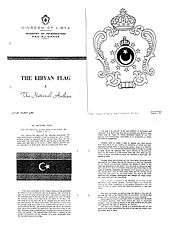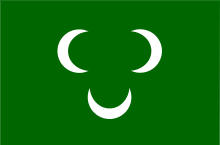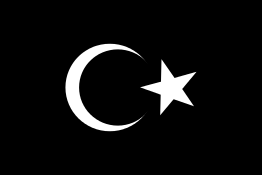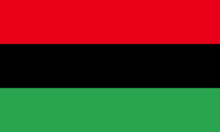Flag of Libya
 | |
| Use | National flag, civil and state ensign |
|---|---|
| Proportion | 1:2 |
| Adopted |
24 December 1951 17 February 2011 (re-adoption) |
| Design | A horizontal triband of red, black (double width) and green; charged with a white crescent and five-pointed star centred on the black stripe. |
|
Variant flag of Libya | |
| Use | Naval ensign |
| Design | a field of light blue, with the flag of Libya in the canton and a white anchor with rope in the fly |
The flag of Libya was originally introduced in 1951, following the creation of the Kingdom of Libya. It was designed by Omar Faiek Shennib and approved by King Idris Al Senussi who comprised the UN delegation representing the regions of Cyrenaica, Fezzan and Tripolitania at UN unification discussions.
The flag fell out of use in 1969, but was subsequently adopted by the National Transitional Council and anti-Gaddafi forces and effectively reinstated as the country’s national flag in article three of the Libyan Draft Constitutional Charter for the Transitional Stage issued on 3 August 2011.[1][2]
Origin and history


The flag of the Kingdom of Libya was adopted when Libya gained full independence in 1951. It consisted of a white star and crescent on a triband red-black-green design, with the central black band being twice the width of the outer bands. The design was based on the banner of the Senussi dynasty from Cyrenaica, which consisted of a black field and star and crescent design, and was later used as the flag of the region.
Omar Faiek Shennib, Chief of the Royal Diwans, Vice President of the National Assembly and Minister of Defense under King Idris Al Senussi is credited in the memoirs of Adrian Pelt, UN commissioner for Libya (1949 to 1951) for the design of the original flag of Libya. According to Pelt: "during deliberations of the Libyan National Constitutional Convention, a paper drawing of a proposed national flag was presented to the convention by Omar Faiek Shennib (distinguished member of the delegation from Cyrenaica). The design was composed of three colors; red, black and green, with a white Crescent and Star centered in the middle black stripe. Mr. Shennib informed the delegates that this design had met the approval of His Highness Emir of Cyrenaica, King Idris Al Senussi (later to become King of Libya). The assembly subsequently approved that design."[3]
This flag represented Libya from its independence in 1951 until the 1969 Libyan coup d'état. The symbolism of the star and crescent in the flag of the Kingdom of Libya was explained in an English language booklet, The Libyan Flag & The National Anthem, issued by the Ministry of Information and Guidance of the Kingdom of Libya (year unknown) as follows: "The crescent is symbolic of the beginning of the lunar month according to the Muslim calendar. It brings back to our minds the story of Hijra (migration) of our Prophet Mohammed from his home in order to spread Islam and teach the principles of right and virtue. The Star represents our smiling hope, the beauty of aim and object and the light of our belief in God, in our country, its dignity and honour which illuminate our way and puts an end to darkness."[4]
In 2011, interviews with Ibtisam Shennib and Amal Omar Shennib, Omar Faeik Shennib's only two remaining children, were cited as confirming Pelt's account of the origin of the flag.[5] Ibtisam Shennib recalled the morning her father brought a draft of the flag to the breakfast table and showed it to her and her siblings, explaining the original intent behind the selection of the flag's colours and symbols. According to Omar Faiek Shennib, "red was selected for the blood sacrificed for the freedom of Libya, black to remember the dark days that Libyans lived under the occupation of the Italians (Italian Libya) and green to represent its primary wealth, agriculture, (Libya once being referred to as the 'agricultural basket' or 'breadbasket' of the Ottoman Empire) and the future prosperity of the country. The star and crescent were placed within the black central strip of the flag as a reference to the Senussi flag and the role of King Idris in leading the country to independence".[3]
During the Libyan Civil War against the rule of Muammar Gaddafi, the 1951–1969 flag – as well as various makeshift versions without the crescent and star symbol, or without the green stripe – came back into use in areas held by the Libyan opposition and by protesters at several Libyan diplomatic missions abroad.[6][7][8] The National Transitional Council, formed on 27 February 2011, adopted the flag previously used in the Kingdom of Libya between 1951 and 1969 as the "emblem of the Libyan Republic".[9][10] The flag was officially defined in article three of the Libyan Draft Constitutional Charter for the Transitional Stage:
The national flag shall have the following shape and dimensions:Its length shall be double its width, its shall be divided into three parallel coloured stripes, the uppermost being red, the centre black and lowest green, the black stripe shall be equal in area to the other two stripes together and shall bear in its centre a white crescent, between the two extremities of which there shall be a five‑pointed white star.
On 10 March 2011, France was the first country to recognize the council as the official government of Libya, as well as the first to allow the Libyan embassy staff to raise the flag.[11] On 21 March, the flag was flown by the Permanent Mission of Libya to the United Nations and appeared on their official website,[12][13] and thereafter in late August by the Arab League[14] and by Libya's own telecommunications authority,[15] the Libya Telecom & Technology, on its own website. In the following months many other Libyan embassies replaced the green flag of Gaddafi with the tricolor flag.
This original flag of Libya is now the only flag used by the United Nations to represent Libya, according to the following UN statement: "Following the adoption by the General Assembly of resolution 66/1, the Permanent Mission of Libya to the United Nations formally notified the United Nations of a Declaration by the National Transitional Council of 3 August 2011 changing the official name of the Libyan Arab Jamahiriya to "Libya" as well as a decision to change Libya's national flag to the original."[16] All Libyan diplomatic posts, such as embassies and consulates, use the original flag of Libya.
Legal basis and construction

The flag of Libya is described in Article 7 of the Constitution of 7 October 1951. It was officially adopted on 24 December 1951. The passage from the constitution reads:
Chapter 1, Article 7: The national flag shall have the following dimensions: Its length shall be twice its breadth, it shall be divided into three parallel coloured stripes, the uppermost being red, the centre black and the lowest green, the black stripe shall be equal in area to the two other stripes combined and shall bear in its centre a white crescent, between the two extremities of which there shall be a five-pointed white star.
Both the precise shade and legal construction is described in a booklet issued by the Ministry of Information and Guidance of the Kingdom of Libya in 1951.[17] The passage reads:
The exact particulars of the Libyan National Flag prescribed by Article 7 of the Constitution shall be as follows: The red shall be sign red, and the green permanent green. The Crescent shall be on the hoistward side of the star, and the centre of the circle of which the crescent forms a part shall be in the centre of the flag. The star shall be in the open end of the crescent and one point of the star shall point to the centre of the circle. The maximum width of the 270 crescent shall equal 1⁄6 of its outside diameter which is 1⁄4 of the width of the flag. The distance between the tips of the crescent shall equal that between the uppermost and lowermost point of the star measured along a perpendicular forming the hoistward sides of these two points. The perpendicular shall form a tangent to the outside circumference of the crescent at a point equidistant from the top and bottom of the flag.

Historical flags

The name "Libya" was introduced by Italian colonialism in 1934. Before 1911, the Ottoman vilayet of Tripolitania (the "kingdom of Tripoli") included much of the same territory as modern Libya.
Tripolitania

The short-lived Tripolitanian Republic in western Libya had its own flag, which had a light blue field and a green palm tree in the center, with a white star on top of it.[18] It was unilaterally declared in 1918 and claimed sovereignty over the entire former vilayet, but never had full de facto governance.
Italian Libya (1934–1943)
.svg.png)
From 1934 to 1943, Libya was an Italian colony and used the flag of the Kingdom of Italy.
Allied occupation of Libya (World War II)
British Military Administration (1942-1951)

The areas of Libya under British military administration (Cyrenaica 1942-1949 and Tripolitania 1943-1951) did not have their own flag and thus, used the Union flag of the United Kingdom.
Military Territory of Fezzan-Ghadames (1943-1951)

During the French Administration of the former Military Territory of the South, Fezzan-Ghadames had a red flag with a crescent and star, very similar to the flag of Turkey.
Emirate of Cyrenaica (1949–1951)

During World War II, Italian Libya was occupied by France and the United Kingdom. The emirate of Cyrenaica was declared in British-occupied Cyrenaica in 1949 with the backing of the British authorities. The "emir of Cyrenaica", Idris of Libya, kept the emirate's flag (a white crescent and star on a black background) as his personal flag after he became king of Libya in 1951.
Libyan Arab Republic (1969–1972)
.svg.png)
Following the coup d'état of 1969, the flag was replaced by the Pan-Arab red-white-black tricolor of the Arab Liberation Flag, first flown after the Egyptian Revolution of 1952 (which also formed the basis of the flags of Egypt, Iraq, Syria, and Yemen).
Federation of Arab Republics (1972–1977)
.svg.png)
In 1972 when Libya joined the Federation of Arab Republics its flag was adopted by the country, linking it to Egypt and Syria. It featured a golden hawk (the "Hawk of Qureish"), holding a scroll with the Arabic name of the Federation.[19]
Great Socialist People's Libyan Arab Jamahiriya (1977–2011)
.svg.png)
.svg.png)
.svg.png)
.svg.png)

The flag of the Libyan Arab Jamahiriya was adopted on 11 November 1977 and consisted of a green field. It was the only national flag in the world with just one color and no design, insignia, or other details.[20] It was chosen by Libyan leader Muammar Gaddafi to symbolize his political philosophy (after his Green Book).[21]
The green colour traditionally symbolises Islam, reflecting the historical green banners of the Fatimid Caliphate. In Libya, green was also a colour traditionally used to represent the Tripolitania region.
List of flags of Libya
-
.svg.png)
Flag of Italian Libya (1934–1942)
-

British Military Administration (1942–1951)
-

Kingdom of Libya (1951–1969)
-
.svg.png)
Libyan Arab Republic (1969–1972)
-
.svg.png)
Federation of Arab Republics (1972–1977)
-
.svg.png)
Great Socialist People's Libyan Arab Jamahiriya (1977–2011)
-

State of Libya (2011—)
See also
References
- ↑ "Libya Draft Constitutional Charter" (PDF) (in Arabic). National Transitional Council. 3 August 2011. Archived from the original (PDF) on 2012-03-31.
- ↑ "Libya Draft Constitutional Charter". scribd.com. Retrieved 8 September 2011.
- 1 2 "National Flag of Libya". 24dec1951.com. 24 December 1951. Archived from the original on 2015-10-31.
- ↑ cited after a copy kept by the library of Swiss Vexillological Society; c.f. Jos Poels at FOTW, 1997.
- ↑ "For Amal, life (re)begins at 75 |". Feb17.info. 19 October 2011. Archived from the original on 2012-09-11.
- ↑ .Libya's monarchist flag: a symbol of anti-Gathafi protest. Middle East Online. Retrieved 27 May 2011.
- ↑ What's in a flag? – Libya. Al Jazeera English. Retrieved 27 May 2011.
- ↑ Mark Tran (17 February 2011). "Bahrain in crisis and Middle East protests – live blog". The Guardian. London. Retrieved 19 February 2011.
- ↑ National Transitional Council ''(Retrieved 13 March 2011)'' Ntclibya.org. Retrieved 27 May 2011.
- ↑ "Libya National Flag". Retrieved 28 July 2011.
- ↑ "Libya: France recognises rebels as government". BBC News. 10 March 2011.
- ↑ "Libya air raid 'killed civilians'". BBC News. 31 March 2011.
- ↑ Libyan Mission New York. Libyanmission-un.org (5 March 2011). Retrieved 27 May 2011.
- ↑ "Libya regains Arab League seat – Africa". Al Jazeera English.
- ↑ "ليبيا للاتصالات و التقنية". Ltt.ly. Retrieved 2016-09-30.
- ↑ United Nations Information Service (Retrieved 19 December 2011)
- ↑ [English translation based on The Libyan Flag & The National Anthem, a booklet issued by the Ministry of Information and Guidance of the Kingdom of Libya, cited after Jos Poels at FOTW, 27 January 1997]
- ↑ "World Statesmen-Libya". Retrieved 12 December 2009.
- ↑ Smith, Whitney; Buhrer, Emil (1975). Flags Through the Ages and Across the World. New York: McGraw-Hill. p. 361. ISBN 0-07-059093-1.
- ↑ "Libya Flag". Retrieved 12 December 2009.
- ↑ "Staff of Libyan consulate in Egypt lower flag". Reuters. 22 February 2011.

